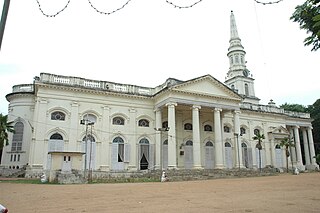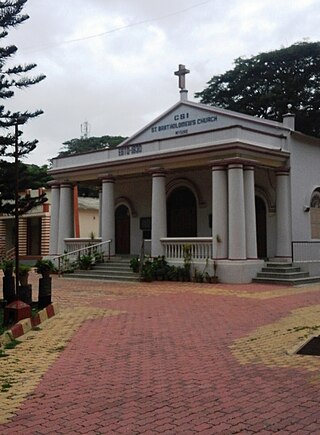
Robert Caldwell was a missionary for London Missionary Society. He arrived in India at age 24, and studied the local language to spread the word of the Bible in a vernacular language, studies that led him to author a text on comparative grammar of the South Indian languages. In his book, Caldwell proposed that there are Dravidian words in the Hebrew of the Old Testament, the archaic Greek language, and the places named by Ptolemy.

St. George's Cathedral is a Church of South India cathedral in Chennai, India. The cathedral was built in 1815. St. George's occupies an important place in the history of Christianity in India, as the Church of South India was inaugurated here on 27 September 1947. It marked the breaking down of ecclesiastical barriers between Protestants of various traditions.
The Coimbatore Diocese is one of the 24 dioceses of the Anglican Church of South India (CSI).

Holy Trinity Church, located at Trinity circle at the east end of the MG Road, is a major landmark in Bangalore. It was built in 1851, for the British Regiment stationed in Bangalore. Built in the English Renaissance style, the church can accommodate 700 people and is regarded as the largest "military" church in southern India. It has a congregation of over 450 families

Peter Percival was a British born missionary and educator who opened religious schools in Sri Lanka and South India during the British colonial era.) During his stay in Jaffna, he led the effort to translate the Authorized King James Version of Bible into the Tamil language, working with the Tamil scholar Arumuka Navalar – a Shaiva Hindu. Percival's work influenced Robert Bruce Foote. Percival began his career in British held Sri Lanka and Bengal as a Wesleyan Methodist missionary. He was instrumental in starting and upgrading a number of Christian schools within the Jaffna peninsula. After returning to England, he converted to Anglicanism. Subsequent to his posting in South India, he severed his association with the Anglican Missionary Society that had sent him to India and worked as an educator in Presidency College in Madras Presidency. He published English-Tamil and English-Telugu dictionaries as well as a number of books on Indian culture and religion. He died in 1882 in Yercaud in present-day Tamil Nadu.

The Malabar Diocese is one of the twenty-four dioceses of the Church of South India covering the Malabar part of Kerala. The diocese consists of CSI churches in the areas Kannur, Wayanad, Calicut, part of Palakkad district and church in Goa. The cathedral church of the diocese is situated at Calicut and the Bishops House at Calicut
The Karnataka Central Diocese is one of the twenty-two dioceses of the Church of South India covering the central part of Karnataka.

St. Mark's Cathedral, dedicated to Saint Mark the Evangelist, is the cathedral of the Diocese of Central Karnataka of the Church of South India. The cathedral church, noted for its English Baroque architecture inspired by the 17th century St Paul's Cathedral, is located at the west end of Mahatma Gandhi Road, MacIver Town, Bangalore.

St. Bartholomew's Church is an Anglican church, built by the Madras Government for the East India Company troops stationed in Kingdom of Mysore and is located in Lashkar Mohalla, on the Nilgiri Road, near the noisy Mysore sub-urban bus stand in Mysore City. The church grounds was consecrated on 29 November 1830 by Bishop Turner of Calcutta, (p. 327) and the building was completed in 1832. The church is named after Saint Bartholomew, one of the 12 apostles of Jesus Christ, and is said to have visited India in the first century AD, and preached the Christian gospel in the Kalyan, Thane and Raigad regions of present-day Maharashtra.
St. Paul's Church is located in the corner of Old Poor House Road, and Bowring Hospital Road, next to the Bowring and Lady Curzon Hospital, Bangalore Cantonment, India. St. Paul's has the distinction of being the very first Tamil Anglican Church in the erstwhile Mysore State. St. Paul's celebrated its 175th anniversary in May 2014. Like most old churches of Bangalore, the congregation of St. Paul's is spread all across Bangalore.
St. John's Church is located in St. John's Hill, Cleveland Town, Bangalore Cantonment, India, in between Promenade Road and St. John's Church Road. The church is the fourth oldest Protestant church in the city, with a distinct red edifice and towering steeple, rising out of the leafy surroundings. The church is dedicated to St. John the Evangelist.
St. John’s Church is located inside the Vellore Fort, Tamil Nadu State, India. The Church was raised in 1846 by the Government of Madras for the officers and men of the East India Company military station. The church is called after St. John the Evangelist. However, the church was never officially consecrated and hence not officially named as St. John’s Church. St. John's Church is the oldest standing church in the Vellore Diocese. The church stands inside the Vellore Fort, which is under the control of the Archaeological Survey of India, along with the Vijaynagar period Jalakanteswarar Temple, Tippu Mahal, Hyder Mahal, Candy Mahal, Badhusha Mahal and the Begum Mahal.

The St. Mark's Church, is located within the Mercara Fort, Coorg, India and was raised in 1859, by the officers and men of the East India Company. The church building was funded by the Government of Madras, and placed under the Church of England in India, Diocese of Madras. The Church was closed after Indian independence, and taken over by the Government of Karnataka in 1971. The building now houses the Madikeri Fort Museum, managed by the Karnataka State Archaeological Department.

The New Jerusalem Church was built in 1718 by the Royal Danish missionary Bartholomaeus Ziegenbalg in the coastal town of Tranquebar, India, which was at that time a Danish India colony. The church is located on King Street, and church services are conducted every Sunday. The church, along with other buildings of the Tranquebar Mission, was damaged during the tsunami of 2004, and were renovated at a cost of INR 7 million, and re-consecrated in 2006.
The Rice Memorial Church is located in the busy Avenue Road, Bangalore Pete. It is named after Rev. Benjamin Holt Rice, a missionary of the London Missionary Society (LMS), a Canarese scholar and a pioneer of education in the Bangalore Pete region. The Rice Memorial Church stands on a busy street in the midst of temple, dargahs, book shops and heavy traffic, with its colonial British structure appearing to be out of place in the traditional Bangalore market district. The church stands on the site of the London Mission Canarese Chapel built by Rev. Rice, which itself was built on the site of the first Canarese chapel built by William Campbell in 1834. The church is a stone building in the European Classical style, with Tuscan columns, pediments and keystone arch windows. The church building has been demolished and raised at least 3 times, with the current structure consecrated in 1917.
The East Parade Church, consecrated in 1865, is located on Mahatma Gandhi Road, in the Bangalore Cantonment. The church comes under the Karnataka Central Diocese of the Church of South India. Started in the early 19th century as the Wesleyan Mission Chapel by Wesleyan believers of the Madras Army with Tamil and English services, the Church now has services in Tamil and Malayalam. The name East Parade comes from its location on the East of the Parade Grounds of the Madras Engineer Group (MEG) regiment. The present church building was raised in 1865, on the site of the old Wesleyan Mission Chapel, with an inscription dated 6 October 1863 marking the laying of the foundation stone.
The United Mission School is located on Mission Road, Bangalore and is managed by the Church of South India. The school offers English medium education and is affiliated to the Karnataka Secondary Education Examination Board. The school has classes from Year 1 to Year 10. In 1993, the United Mission Degree College was established on the same campus, offering Bachelor of Commerce and Bachelor of Business Management courses, affiliated to the Bangalore University.

CSI Immanuel church, Salem is located on Sarada College Rd, in the heart of Salem, Tamil Nadu, India. The church services are conducted both in Tamil and English.

Benjamin Henry Arthur Margoschis was a Protestant Christian missionary in India. He served the Society for the Propagation of the Gospel in Foreign Parts (SPG) as an overseas missionary in India. The inhabitants of Nazareth, a small town in Tamil Nadu, called him the "Father of Nazareth" and Margoschis Aiyar. Aiyar means clergyman in the native language. Reverend Margoschis was responsible for the development of the small town of Nazareth, which is situated at the southern part of Tamil Nadu, India.
Samuel Thomas Pettigrew (1827–1889) was an East India Company chaplain, who served in Rangoon, Kamptee, Bangalore, Ootacamund and Trivandrum, and is credited with establishing the Bishop Cotton's School and Cathedral High School in Bangalore.













